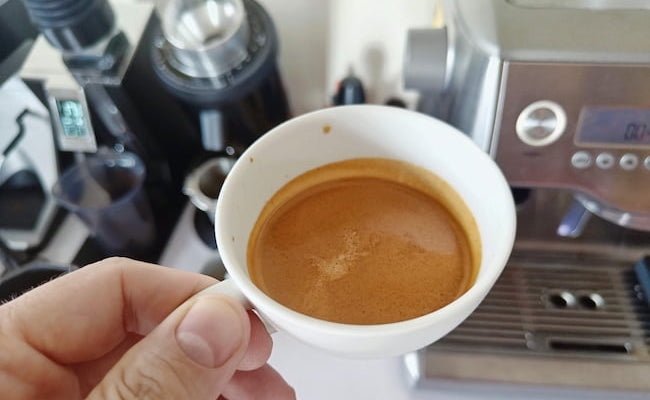Espresso is unlike any other type of coffee.
And besides the machine, the grinder is the most critical part of the espresso equation.
There are many myths and misunderstandings regarding espresso grinders, so in this article, I’ll break down everything you need to know and give you my top recommendations.
Straight to the Point
My top picks for espresso grinders are the DF64 Gen 2 and the 1Zpresso J. The DF64 Gen 2 is more convenient since it’s electric, and also tastes better due to its flat burr geometry. The J one the other hand, is one of the most affordable epresso grinders on the market and punches well above its weight.
Authentic espresso vs. “mock” espresso
Before we get into the meat of the article, let’s clear up some confusion:
Mock espresso looks like the real thing but relies on a pressurized basket. This basket fundamentally changes the extraction process and enables you to use a coarser grind size. So if you have an espresso machine with this type of basket or portafilter, you can use a regular coffee grinder. (Generally, entry-level machines under 150$ use this technology).
The same goes for the Moka pot (Italian stovetop espresso maker). Again, some people think that this is espresso. It’s not. You don’t need a dedicated espresso grinder for this type of coffee.
Authentic espresso is made with a non-pressurized basket and is extracted between 6-10 bars. This is why pulling a shot requires an extremely fine grind size; the grind size has to provide all the resistance to the water pressure.
To recap: You only need a legit espresso grinder if you’re making legit espresso!
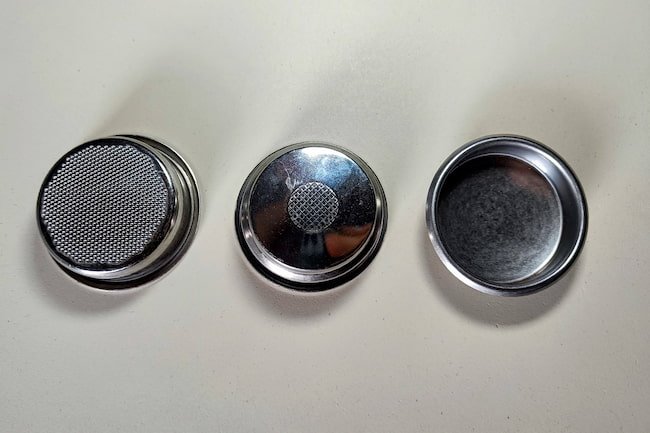
| Coffee Grinder | Grind Settings | Burr Size | Grind Speed | Grind Retention | Hopper Capacity | Portafilter Holder | Digital Display | Weight |
|---|---|---|---|---|---|---|---|---|
| Baratza Sette 30 | 30 | 40 mm | 3.5-5.5g/sec | 0.2g | 350g | Yes | Yes | 3.2kg |
| DF54 Gen 2 | ∞ | 54 mm | 1-2.5g/sec | 0.1g | 50g (with bellows) | Yes | No | 4.5 kg |
| DF64 Gen 2 | ∞ | 64 mm | 1-2g/sec | 0.1g | 70g (with bellows) | Yes | No | 6.8 kg |
| Eureka Mignon Specialita | ∞ | 55 mm | 1.2-1.8g/sec | 1-2g | 300g | Yes | Yes | 5.6kg |
| 1Zpresso J | 90 | 48 mm | 0.5-1g/sec | 0.1g | 30-35g | No | No | 683g |
| 1Zpresso J-Ultra | 200+ | 48 mm | 0.4–0.8g/sec | 0.1g | 35g | No | No | 680g |
A cheap grinder for espresso?
My recommendation for a solid cheap espresso grinder is this one: The 1zpresso Jx, which is a hand grinder.
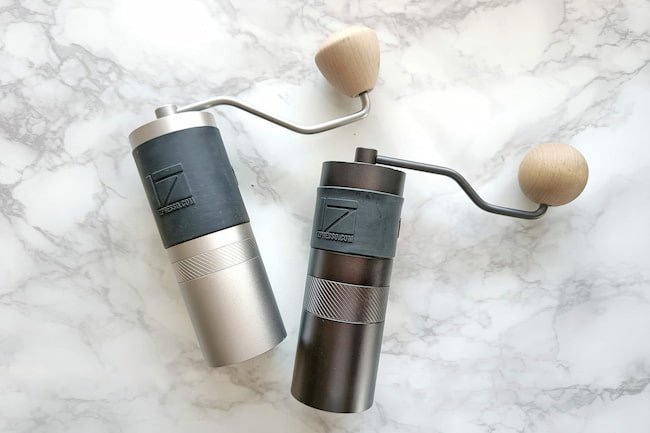
Many of my followers have picked up a Jx over the last couple of years, and I have almost exclusively heard great things from them.
I was blown away after testing the Jx a few years back, and actually 1Zpresso has improved the grinder with small incremental updates.
It’s just excellent value for money and does a good job grinding for both drip coffee and espresso. In addition, it’s easy to clean and silent in operation.
Hand grinders naturally score high on many of the evaluation criteria for espresso grinders: They have low retention, consistent doses, and provide fluffy grinds. They are also very quiet compared to most electric models.
⚠️ A word of caution: Some people find hand grinding physically exhausting. While manual brewing methods are more comfortable to grind, espresso can be a struggle. It just requires much more torque.
If the mere idea of a couple of push-ups or doing ten reps with a dumbbell sounds frightening, then you probably won’t enjoy hand grinding.
If you’re not in great shape, you should probably consider an electric grinder.
The ideal single-dose espresso grinder
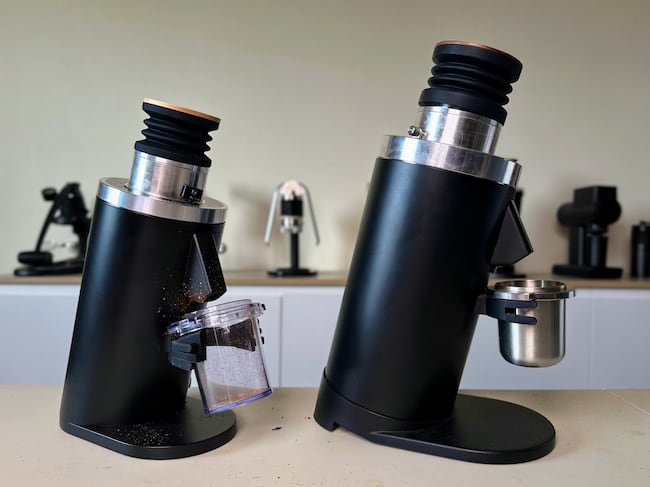
If you are not keen on hand-grinding, I have another excellent option for you.
The DF64 is back in a new and updated version, the so-called Gen 2.
This update really fixes ALL the problems that plagued the old model.
You should check out my review of this grinder for more in-depth information, but to give you a brief recap, I think this is a fantastic deal for the money.
The good thing about single-dose grinders is that switching between many brew methods is much easier. So you can easily go from espresso to French press if you want.
This is also a sturdy grinder that is future proof since it can be upgraded with SSP burrs easily. Overall, it’s very appealing option!
If you are on a budget the brand, brand new DF54 is an even better option. It offers a lot of the same pros as its bigger brother, and the flavor is on a similar level – the main downside is that you don’t have access to the same amount of aftermarket burrs. It’s also a bit slower. But that shouldn’t be a big deal in a domestic setting.
The most Suitable espresso grinder for regular people
The Eureka Mignon Specialita is an excellent option for most people. It’s a light commercial-level grinder with a tiny footprint.
Unlike the DF64, this is a hopper-based espresso grinder. This means that you typically fill a whole bag of beans into the upper compartment of the grinder.
Again, I’d encourage you to check out my full review for an in-depth explanation of all its features.
The shots made with this grinder tend to be sweet and balanced with just the right amount of texture.
In addition, since it uses flat burrs (as opposed to conicals like the Jx and Baratza Sette), the flavor profile is just a bit more smooth and more long-lasting. This is what I personally prefer when it comes to espresso.
Basic requirements
Espresso grinders tend to be expensive!
They are a lot more expensive than regular coffee grinders (which can already be quite pricy).
So unless you’re ready to spend at least a few hundred dollars, you’ll be very limited in your options.
In my opinion, hand grinders are the only option in this price range.
You’ll see some manufacturers claiming that their grinder can “grind for espresso,” but they are frustrating or useless in practice. A grinder like the Baratza Encore sometimes gets recommended, but IMO it’s just a way too disappointing experience to try to use something like that for authentic espresso.
So what does it take to grind for espresso?
- First, the grinder must be able to grind very, very fine.
- Second, it should be possible to make micrometric adjustments to the grind size. These changes should be small enough that you can change the timing of the shot in a meaningful and repeatable way. If the tiniest change in setting changes your shot time by more than 6-10 seconds, it’s a serious flaw.
These are just the basic requirements, though.
The following requirements on my list are not strictly necessary. However, I consider them quite essential for a good espresso grinding experience:
- Consistent doses: If you put 18 grams of beans in, you should get 18 grams out (+/- 0,3 grams)
- Low retention: The grinder shouldn’t hold onto considerable amounts of old coffee. You want as little old coffee as possible to be retained in the grinding chamber or/chute.
- Micrometric adjustments: You’ll see grinders with both stepped and stepless adjustments. Both types can have their place. You can control the shot time down to a few seconds by adjusting the grind size to finer or coarser.
- Fluffy grounds: Some grinders can grind very fine but tend to produce clumpy grounds. This is not ideal and can cause uneven extraction. IMO fluffy grounds should be a factor in your buying decision.
- Consistent grinds: The grinds should also be rather uniform. However, some microdust, aka fines, can add mouthfeel to the shot.
- Smooth workflow: Since espresso grounds are tiny particles, they can easily create a mess. A good grinder makes it simple, clean, and easy to transfer the grounds into the portafilter.
- Intelligent Dosing: Dosing refers to measuring “the dose”. Some grinders have a timer that works down to a tenth of a second, giving you almost an identical amount of coffee every time. Other grinders use built-in scales to achieve this.
- Single Dosing: Some grinders are optimized for “single dosing.” This means you measure the beans before putting them into the grinding chamber. These grinders don’t have a hopper.
- Solid construction/engineering: Grinding for espresso is much more demanding than grinding for regular coffee types. For that reason, the equipment should be sturdy and well-built.
My favorite espresso grinders of 2024
1Zpresso J

The 1Zpresso J (formerly known as Jx) has been one of my favorites since it was released in 2019, and even though a lot has happened since then, it’s still a great option.
For a manual grinder, it’s super fast and consistent. With its smooth ball bearings and 48 mm, steel conical burrs, it chews through beans quickly.
It has a solid design which is excellent in hand and easy to take apart for deep cleaning.
It also works for other brewing methods such as pour over or AeroPress.
This grinder easily competes with and beats much more expensive grinders such as Baratza Virtuoso and Breville Smart Grinder Pro.
Sometimes, you’ll hear that the basic J is not suitable for espresso and that you should upgrade to the Jx Pro, which offers more granularity. However, this is not correct anymore. Since the adjustment dial was revised on the J with the new update over a year ago, it has had sufficient settings to dial in a shot.
➡️ Read the full 1Zpresso J review here
amazon 1zpressoDF54
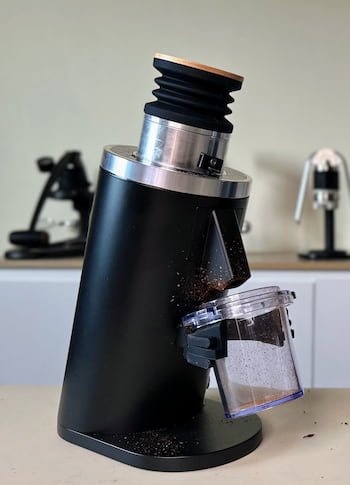
The DF54 is the latest addition to the DF grinder lineup.
I’m one of the few people who has been lucky enough to already try it, and I have to say I think it will become a new smash hit!
With its compact design, 54mm flat burrs, and an astonishingly low price, this grinder delivers exceptional performance without breaking the bank.
The wide grind adjustment range and easy-to-use dial make dialing in and switching between different settings very straightforward.
One of the most impressive aspects of the new model is its grind quality. Despite its smaller burr size compared to the DF64, the DF54 manages to produce consistent and uniform grinds for both espresso and filter coffee. In fact, it’s hard to tell the difference between the two grinders in shot quality.
The DF54 is, in many ways, exactly the same as the DF64—just in a smaller package. It has the same sturdy metal construction, anti-static technology, and single-dose workflow.
Check out my full YouTube review here 👇
While the DF54 may not have the same availability of aftermarket burr as its bigger sibling, that’s not a huge deal as the grinder is not quite aimed at uber-geeks who want to experiment with burrs swaps.
Rather, it’s for more regular/sane people. Keep in mind that the price of this grinder is around the same as a set of SSP burrs – that puts things in perspective.
For me, the DF54 is a game-changer in the entry-level to midlevel grinder space. It offers what I would call prosumer performance and a single-dose workflow at a very low price point.
If you’re in the market for a single-dose grinder that can handle a wide range of brewing methods without breaking the bank, the DF54 should be on your radar.
As an added bonus, the grinder is also excellent for pour-over. So if you wish to use it for other things besides espresso, then that’s no problem.
MiicoffeeDf64 Gen 2

The DF64 (which also goes by a range of other names, among them Turin and G-IOTA) quickly made a name for itself when it was released in early 2021.
Let’s be frank here; the first version of the grinder, while a good deal on paper, did have a lot of annoying issues that users had to deal with (very messy and lacking in UX features).
Now the company is back with an upgraded Gen 2 version that just improves on the original in every single way.
It’s less messy, has a more refined finish, better button positioning, and nicer accessories (aluminum catch cup, steel dosing ring, adjustment dial indicator, and a stylish wooden lid.)
The DF64 Gen 2 fills a gap in affordable single-dosing grinders, setting it apart from competitors like the Niche Zero. Its compatibility with SSP burrs (and many other aftermarket burrs) makes it even more appealing.
Sporting a sturdy 15-pound frame, the Gen 2 DF64’s 250-watt motor deftly handles diverse settings.
The new antipopcorn disc complemented by a swift 1400 RPM burr operation, ensure quick grinding speeds. You can run through a double-espresso dose in less than 10 seconds.
This grinder not only rectifies the issues of its earlier model, but also adds some new innovative ideas like the plasma generator, which cuts down static electricity.
In conclusion, the Gen 2 DF64 offers a blend of innovation, efficiency, and great value.
If you want an all-round single-doser, this grinder stands out as one of top choices in 2023.
➡️ Read the full DF64 review here
amazon miicoffee1Zpresso J-Ultra
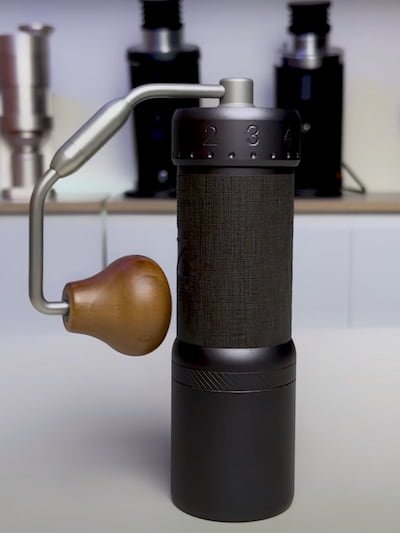
The J Ultra is the upgrade pick to the J. It’s more expensive, but you do get a lot of value for that extra bit of money!
Before I dive into what makes the J Ultra special, let me give you a quick history lesson on 1Zpresso’s espresso grinders. Back in 2021, they released the J Max as an upgrade to the popular JX Pro. However, there was another lesser-known espresso grinder in their lineup called the JE and JE Plus, which I absolutely loved. The JE had a similar sturdy and simple design to the JX, but it featured a different burr set from Italmill that delivered incredibly thick and balanced espresso shots. Sadly, the JE was discontinued shortly after its release.
When the J Max came out, it had some cool features like a magnetic catch cup and ultra-fine external adjustments that made it look more interesting on paper. But in terms of actual performance, I found that it didn’t quite live up to the JE, especially when it came to medium and light roasts. That’s why I started recommending the K series for espresso, as it seemed to handle a wider range of roasts and brewing styles.
But now we have the J Ultra. At first glance, it looks very similar to the K Ultra – 1Zpresso’s filter-focused flagship grinder.
The main difference is in the adjustment ring design, which I think looks a bit more elegant on the J Ultra. Compared to the bulky J Max, the J Ultra is slimmer and lighter at 670g, making it much more comfortable to hold and operate, even if you don’t have massive hands. The reduced torque also means it’s easier on the wrists, although it does grind a bit slower than the J Max.
One of the standout features of the J Ultra is its incredibly precise grind adjustment. With steps of just 8 microns (even finer than the J Max’s 8.8 microns), you get an unparalleled level of control over your grind size. During my testing, I found that even 1-2 clicks of adjustment would only change the shot time by 1-3 seconds. This level of precision is a double-edged sword, though. While it allows for super fine-tuning, it also means you need to keep pay more attentions to your settings. It can be a bit confusing at times; for example if you’re going from espresso to pour over.
What really matters is the flavor in the cup. And let me tell you, the J Ultra delivers. The shots I have pulled with this grinder are beautifully balanced, with a big, satisfying body and a clean, elegant finish. It’s about as good as it gets for a conical burr grinder in this price range. The flavor hits every part of your palate in a delightful way, taking you on a journey with each sip. I even had a few “god shots” that were just pure perfection – sweet, punchy, and well-rounded in my testing period.
You can see my full review here in this YouTube video
If I had to nitpick, I wouldn’t mind if the J Ultra ground a bit faster, more in line with the speeds of the J and J Max grinders. Also, it’s only mediocre when it comes to drip or pour-over coffee, but that’s not too surprising given its focus on espresso.
So if you’re primarily an espresso drinker in the market for an exceptional manual grinder, the J Ultra is a no-brainer. The flavor profile reminds me of much more expensive grinders like the Mx Cool Aries with its 83mm conical burrs, which just goes to show the incredible value for money you get with the J Ultra. And of course, the overall user experience is top-notch, as you’d expect from 1Zpresso.
amazon 1zpressoBaratza Sette 30

This is a great option if you want to brew great espresso at home without spending a fortune. This model has 40mm conical burrs from venerated burr manufacturer Etzinger, which produces a rich flavor profile with medium clarity and a medium-high body.
The Sette (as the name indicates) only has 30 grind settings, so it may be harder to dial in than the more expensive 270 version, but if you’re willing to be flexible and adjust by using dose and/or tamp pressure, then it’s doable.
The Baratza Sette 30 offers all the great things that the more expensive version does, and the price point is just right.
If you consider the jump up to the Sette 270 and 270wi, you suddenly have a lot of capable competitors. I’d be more inclined to choose the DF64 or a grinder in the Eureka Mignon series in that range.
So, in my opinion, the Sette 30 is the most interesting version. Check out my full review below to see what makes it so great.
➡️ Read the full Baratza Sette 30 review here
amazon Chris CoffeeEureka Mignon Specialita
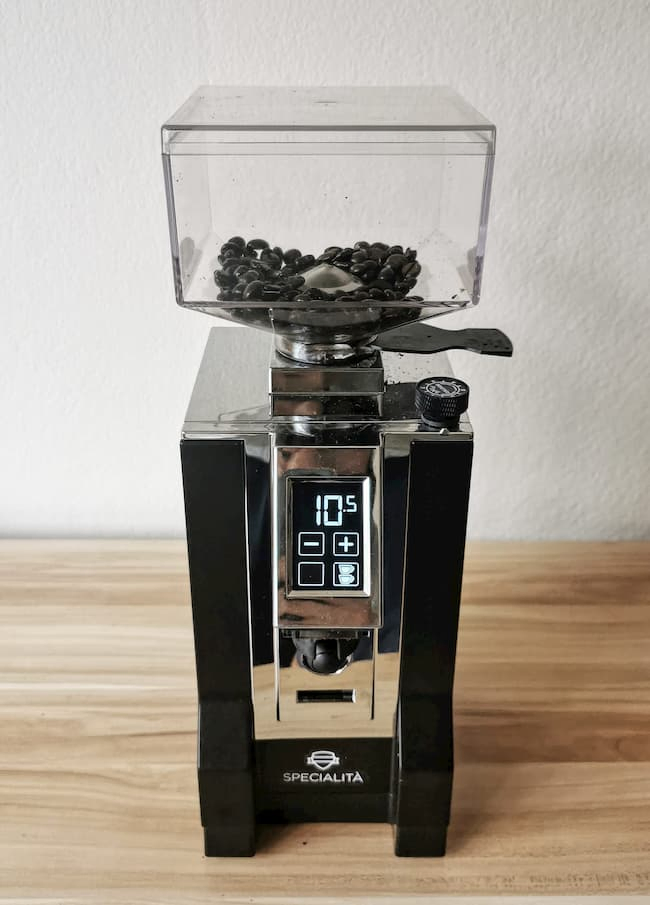
Eureka is one of Italy’s most famous coffee brands; it has been making espresso grinders since 1920. Today the company still makes its products by hand in Florence, Italy.
They’ve been making grinders for years, so it’s no wonder they make some solid products, especially regarding serious espresso grinders.
The Eureka Mignon Series, from which the “Specialita” is one of the flagship products, is one of the company’s biggest hits to date.
All Mignon grinders are exceptionally well constructed while still compact and pleasing to the eye.
There are several enticing models in this range, including the even cheaper Silenzio and the “Zero,” which have been optimized for single dosing.
(I have actually tested the very similar Zero grinder for a while, but don’t think that its a compelling package compared to the Specialita. Eureka just seems to be better at hopper-based dosing rather than single dosing)
Single dosing may be the hottest trend, among hardcore coffee geeks at the moment. But there are still many, many regular people who like the easier workflow of a hopper. For that reason, the Mignon Specialita is a great option for most espresso drinkers out there. The time-based dosing is just excellent and super convenient.
I’ve been using this little gem for about three years now, and I’m not going to lie – it gets used more than any other espresso grinder I own. This is my go-to spro grinder!
➡️ Read the full Eureka Mignon Specialita review here
amazon coffee brosFlat and conical burr differences
You’ll see both flat and conical burrs when we’re talking espresso.
One shouldn’t discriminate and generalize too much here. For example, it’s possible to make great-tasting espresso with both types of burr.
Generally, you’ll mainly encounter burrs made of steel when we’re talking espresso. Ceramic burr grinders are not anything serious coffee geeks pay much attention to.
⚠️ Sidenote: Blade grinders are, of course, NOT recommended for any serious coffee preparation!
Generally speaking, 99% of manual grinders have conical burrs, so if you choose to go down that route, this is your only option.
If we’re really splitting hairs, I think flat burrs offer more clarity and a cleaner aftertaste than conicals. But this is just the general trend. There are muddy flat burrs and clean conical burrs out there, so there are no rules without exceptions.
Another benefit of flat burr grinders is that you have many options when you get up to specific common burr sizes. For example, in the 64 mm range, you’ll have a lot of aftermarket options from other brands, which can add new life to your grinder. If you’re tired of the flavor profile of your grinder, you can invest in a new set of burr, and suddenly it’s like having a new world of flavor opens up to you.
Hopper-based dosing vs Single dosing
These two philosophies also deserve their own section.
Hopper-based dosing is the traditional way to grind for espresso. You have a hopper full of espresso beans attached to the grinder. This is practical because you can just press the button and then coffee falls into your portafilter. If you run a busy café this workflow makes a lot of sense.
However, as home baristas have become more sophisticated, they have started questioning whether this concept. Most grinders have some coffee grounds retained in the grind chamber and chute, which is not purged until you grind for a new shot. This means that there’s some exchange of older grounds with every shot. In a coffee shop where you pull new shots all the time, these coffee grounds won’t go stale. But if you’re making coffee at home, then this is a bigger concern.
For that reason, the single-dose philosophy has started to become more popular. A well-engineered single-dose coffee grinder is optimized for very low or zero retention. So if you measure out 18 grams of coffee for your shot that’s also what you get out.
Single dose pros & Cons
Another big advantage for single-dosers is that it encourages experimentation. If you don’t have a hopper full of coffee to dictate what you have to brew next, then it’s a lot easier to switch between many different bean types from shot to shot.
Some hopper-based grinders work very well for this workflow without any modification. The Baratza Sette comes to mind here. But there are several new models specifically designed for this approach; the Niche Zero and DF64 are probably some of the most famous ones.
And don’t forget that all manual grinders are by default single-dose grinders!
Even though single-dosing undeniably is a trend on the rise, there are still good arguments for getting a grinder with a hopper and an efficient dosing mechanism. If you don’t want to switch between various blends and use scales to measure your dose every time, then the old approach is still more convenient.
If you want to make lattes and traditional espresso shots that taste consistent from brew to brew, then a more traditional grinder is preferable.
Our expertise & Credentials
- Asser Christensen earned his Q Grader license (certified coffee quality grader) in 2018, with recertification in 2021.
- The Q Grader exam requires passing rigorous blind tasting cupping protocols, as well as tests for identifying green bean and roasting defects.
- He has served as a sensory judge at roasting and coffee brewing competitions.
- Over the last 5 years, he has tested more than 50 different coffee grinders, as documented on this blog and his YouTube channel.
